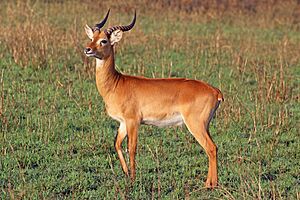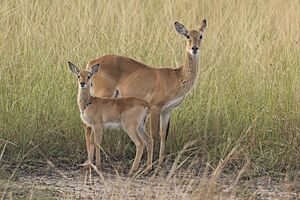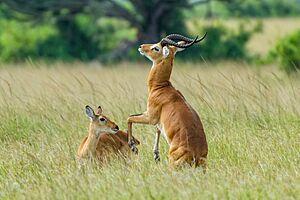Ugandan kob facts for kids
Quick facts for kids Ugandan kob |
|
|---|---|
 |
|
| Male | |
 |
|
| Female and calf both at Semliki Wildlife Reserve, Uganda |
|
| Conservation status | |
| Scientific classification |
|
| Kingdom: | Animalia |
| Phylum: | Chordata |
| Class: | Mammalia |
| Order: | Artiodactyla |
| Family: | Bovidae |
| Genus: | Kobus |
| Species: | |
| Subspecies: |
K. k. thomasi
|
| Trinomial name | |
| Kobus kob thomasi (Sclater, 1864)
|
|
The Ugandan kob (Kobus kob thomasi) is a type of antelope. It is a subspecies of the larger kob family. You can find this animal in parts of sub-Saharan Africa, specifically in South Sudan, Uganda, and the Democratic Republic of the Congo. The Ugandan kob usually has a reddish-brown coat, which helps tell it apart from other types of kob.
This special antelope is so important to Uganda that it appears on the country's coat of arms of Uganda. It's shown there alongside a grey crowned crane, symbolizing the rich and diverse wildlife found in the nation.
Contents
What Does the Ugandan Kob Look Like?
The Ugandan kob looks a bit like an impala, but it's built more strongly. Only the male kobs have horns. These horns are shaped like a lyre (a U-shaped musical instrument), have strong ridges, and spread outwards.
Male kobs are a little bigger than females. They stand about 90 to 100 centimeters (around 3 feet) tall at the shoulder. On average, they weigh about 94 kilograms (207 pounds). Female kobs are about 82 to 92 centimeters (around 2.7 to 3 feet) tall and weigh about 63 kilograms (139 pounds).
Most of their body is golden to reddish-brown. This color helps tell them apart from other kob subspecies. However, their throat, muzzle (nose and mouth area), the ring around their eyes, and the inside of their ears are white. Their belly and the inside of their legs are also white, and the front of their lower front legs are black.
Where Do Ugandan Kobs Live?
The Ugandan kob is originally from East Africa. You can find them in South Sudan (west of the Nile River), Uganda, and the northeastern part of the Democratic Republic of Congo. In the past, they also lived in northwestern Tanzania near Lake Victoria and in southwestern Kenya. However, they are no longer found in those areas.
These animals usually live in open grasslands or savannas with some trees. They always stay fairly close to water sources like rivers and lakes. Because they often rest in open grasslands, they can be easy targets for poachers. This is why most of the Ugandan kob population (about 98%) now lives in national parks and other protected areas.
How Do Ugandan Kobs Live and Reproduce?
Ugandan kobs are herbivores, meaning they eat plants. Their diet mainly consists of grasses and reeds. Female kobs and young male kobs often form groups. The size of these groups changes depending on how much food is available. They often move along rivers and graze in low-lying valley areas. One group in South Sudan was observed traveling up to 200 kilometers (124 miles) during the dry season to find food. Sometimes, male kobs who are not yet ready to breed form their own separate groups.
Female kobs can start having babies when they are about two years old. However, male kobs usually don't start breeding until they are older.
Larger groups of kobs often use a special way of mating called a lek mating system. In this system, females live in loose groups and only visit special breeding grounds to find a mate. At these breeding grounds, male kobs claim small areas of land, sometimes as small as 200 square meters (about 2,150 square feet). The smallest territories are found in the middle of very crowded lek areas.
Baby kobs are usually born at the end of the rainy season, in November or December. A female kob typically gives birth to one calf after being pregnant for about nine months.
Images for kids
-
Female and calf
both at Semliki Wildlife Reserve, Uganda






